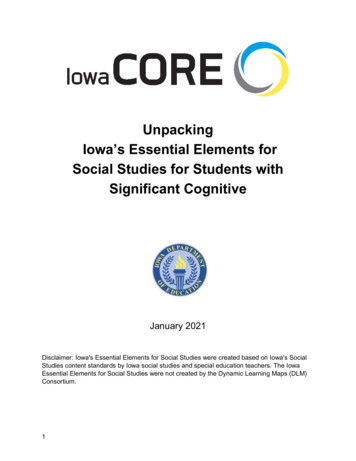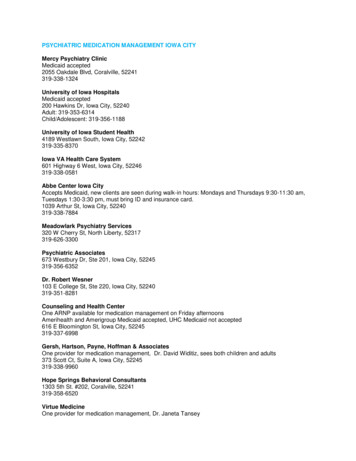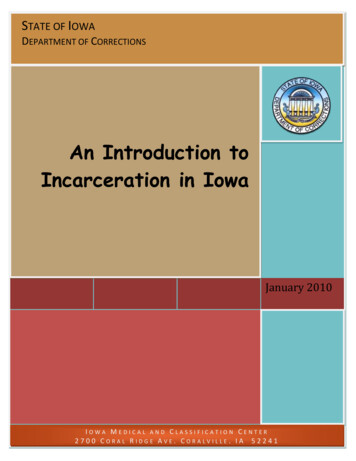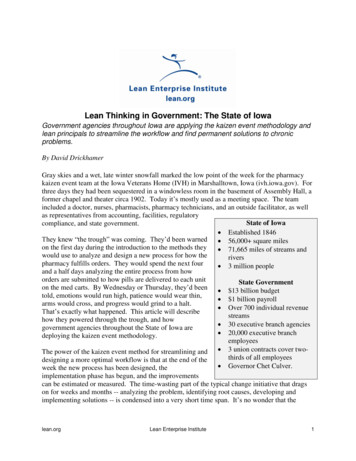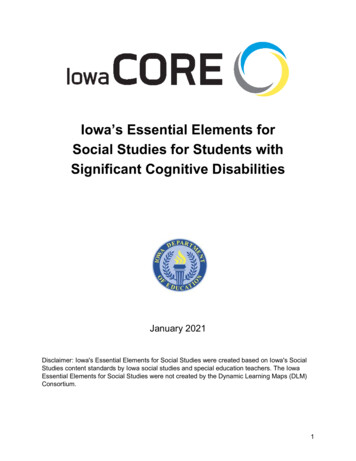
Transcription
Iowa’s Essential Elements forSocial Studies for Students withSignificant Cognitive DisabilitiesJanuary 2021Disclaimer: Iowa's Essential Elements for Social Studies were created based on Iowa's SocialStudies content standards by Iowa social studies and special education teachers. The IowaEssential Elements for Social Studies were not created by the Dynamic Learning Maps (DLM)Consortium.1
ContentsIntroduction .3System Alignment .3Access to Instruction and Assessment .3Guidance and Support .4Color Coding of the Standards .6Inquiry Anchor Standards .6Content Anchor Standards .6Kindergarten: Spaces and Places .71st Grade: Communities and Culture .102nd Grade: Choices and Consequences .143rd Grade: Immigration and Migration .184th Grade: Change and Continuity .235th Grade: Right and Responsibilities .276th Grade: World Regions and Cultures .317th Grade: Contemporary Global Studies.368th Grade: United States History and Civic Ideals .419-12 Social Studies .469-12 Behavioral Sciences .489-12 Civics and Government .529-12 Economics .559-12 Financial Literacy .579-12 Geography .599-12 United States History .619-12 World History .64K-12 Inquiry Standards Progressions .67K-12 Standards Progressions .772
IntroductionThe Iowa Core Essential Elements (EEs) are specific statements of knowledge and skills linkedto the grade-level expectations identified in the Iowa Core Standards. The purpose of the EEs isto build a bridge from the content in the Iowa Core Standards to academic expectations forstudents with the most significant cognitive disabilities.This document provides a high‐level view of the relationship between the Iowa Core Standardsand the links to performance for students with the most significant cognitive disabilities. Thedocument is not intended as a stand‐alone guide to instruction, nor is it intended to contain allthe steps in a complete learning progression or detailed curriculum.These EEs are not intended as a redefinition of the standards. Rather, they are intended todescribe challenging expectations for students who meet participation criteria for instruction andassessment aligned to alternate academic achievement standards in relation to the Iowa CoreStandards. The EEs clarify the bridge between grade‐level academic achievement expectationsfor students with the most significant cognitive disabilities and the Iowa Core Standards.Neither are the EEs intended to prescribe the beginning or end of instruction on the content andskills they represent; rather, they indicate the grade level at which initial mastery would be thetarget to be assessed locally, at the district or building level.System AlignmentThe EEs are intended to contribute to a fully aligned system of standards, curriculum, teaching,learning, technology, and assessment that optimize equity of opportunity for all students in eachclassroom, school, and local education agency to access and learn the standards. To thedegree possible, the grade level Iowa Core EEs are vertically aligned and linked to the gradelevel Iowa Core Standards.The linkages provided by the EEs to the Iowa Core Standards are intended to increase accessto the general curriculum for all students with disabilities. Just as the EEs are designed todefine achievement in academic content areas linked to the Iowa Core, the EEs reframe theexpectations for foundational skills in pre‐academic and academic areas. Precursor/prerequisiteand the unique enabling skills related to English language arts content is specified in the contextof their roles as a foundation for students with the most significant cognitive disabilities toachieve skills related to academic content. The EEs are designed to allow students with themost significant cognitive disabilities to progress toward the achievement of state standardslinked to grade level expectations. The relationship of standards and assessment to teachingand learning are depicted for use by teachers, assessment designers, and users of alternateassessment results.Access to Instruction and AssessmentThe EEs developed by Iowa teachers are intended to create the maximum possible access tothe Iowa Core Standards for students with the most significant cognitive disabilities. The way inwhich information is presented for instruction and assessment and the manner in which studentsdemonstrate achievement is in no way intended to be limited by statements of EEs. To that end,3
modes of communication, both for presentation or response, are not stated in either the EEsunless a specific mode is an expectation. Where no limitation has been stated, no limitationshould be inferred. Students’ opportunities to learn and to demonstrate learning should bemaximized by providing whatever communication, assistive technologies, augmentative andalternative communication (AAC) devices, or other access tools that are necessary and routinelyused by the student during instruction.Students with the most significant cognitive disabilities include a broad range of students withdiverse disabilities and communication needs. For some students with the most significantcognitive disabilities, graphic organizers similar to those used by students without disabilitiesprovide useful access to content and are adequate to maximize opportunities to learn anddemonstrate achievement. Other students require a range of assistive technologies to accesscontent and demonstrate achievement. For some students, AAC devices and accommodationsfor hearing and visual impairments will be needed. As with other physical disabilities, studentswith visual impairments may perform some expectations using modified items, presentations, orresponse formats. A few items may not lend themselves to such modifications. Decisions aboutthe appropriate modifications for visual impairments are accounted for in the design of theassessments.The access challenge for some is compounded by the presence of multiple disabilities. All ofthese needs, as well as the impact of levels of alertness due to medication and other physicaldisabilities which may affect opportunities to respond appropriately, need to be considered.Guidance and SupportThe authors of the Iowa Core Standards use the words, “prompting and support” at the earliestgrade levels to indicate when students were not expected to achieve standards completelyindependently. Generally, “prompting” refers to “the action of saying something to persuade,encourage, or remind someone to do or say something” (McKean, 2005). However, in specialeducation, prompting is often used to mean a system of structured cues to elicit desiredbehaviors that otherwise would not occur. In order to communicate clearly that teacherassistance is permitted during instruction of the EEs, and is not limited to structured promptingprocedures, the decision was made by the stakeholder group to use the more general termguidance throughout the EEs.Guidance and support during instruction should be interpreted as teacher encouragement,general assistance, and informative feedback to support the student in learning. Someexamples of the kinds of teacher behaviors that would be considered guidance and supportinclude Getting the student started (e.g., “Tell me what to do first.”),Providing a hint in the right direction without revealing the answer (e.g., Student wants towrite dog but is unsure how, the teacher might say, “See if you can write the first letter inthe word, /d/og.”),Narrowing the field of choices as a student provides an inaccurate response,Using structured technologies such as task specific word banks, or4
Providing the structured cues such as those found in prompting procedures (e.g., least‐to‐most prompts, simultaneous prompting, and graduated guidance)5
Color Coding of the StandardsThe standards are color-coded to allow for quick identification of the content area of the standard.Behavioral SciencesYellowCivics andGovernmentBlueEconomicsFinancial y Anchor StandardsEach grade level within the K-8 standards includes a set of inquiry standards. At the 9-12 level, there is one set of inquiry standards.These inquiry standards define key disciplinary skills within social studies. The inquiry anchor standards are the same throughout thedocument, but the standard that flows from each anchor standard is more complex as students move throughout their K-12 social studiesexperience. The inquiry standards should be taught in conjunction with the content standards.The K-12 inquiry anchor standards are: Constructing compelling questionsConstructing supporting questionsGathering and evaluating sourcesDeveloping claims and using evidenceCommunicating and critiquing conclusionsTaking informed actionContent Anchor StandardsEach grade level within the K-8 standards includes a set of content standards that encompasses the key disciplines that make up socialstudies. At the 9-12 level, these content standards are pulled out by the discipline. The content anchor standards are the samethroughout the document, but the standard that flows from each anchor standard is more complex as students move throughout their K12 social studies experience. The content standards should be taught in conjunction with the inquiry standards.21st century skills connected with the civics/government and financial literacy standards. This indicates that this standard shows up in thesocial studies standards and the 21st century skills standards.6
Kindergarten: Spaces and PlacesIn kindergarten, students will engage in learning about themselves, their school, city, and state. They will have opportunities to comparehow life in the past is different from life today with respect to their own experiences.Inquiry Anchor StandardAlternate Inquiry Anchor StandardConstructing Compelling QuestionsConstructing QuestionsSS.K.1. Recognize a compelling question.EE.SS.K.1. With guidance and support, recognize a question abouta familiar topic.Constructing Supporting QuestionsConstructing Supporting QuestionsSS.K.2. Identify the relationship between compelling andsupporting questions.EE.SS.K.2. N/ACommunicating and Critiquing ConclusionsCommunicating and Critiquing ConclusionsSS.K.3. Construct responses to compelling questions usingexamples.EE.SS.K.3. N/AGathering and Evaluating SourcesGathering and Evaluating SourcesN/AN/ADeveloping Claims and Using EvidenceDeveloping Claims and Using EvidenceN/AN/ATaking Informed ActionTaking Informed ActionSS.K.4. Take group or individual action to help address local,regional, and/or global problems.EE.SS.K.4. With guidance and support, identify a civic problem intheir classroom.SS.K.5. Use deliberative and democratic procedures to makedecisions about and act on civic problems in their classrooms.EE.SS.K.5. N/A7
Content Anchor StandardsAlternate Content Anchor StandardRecognize the Interaction Between the Individual andVarious GroupsRecognize the Interaction Between the Individual and VariousGroupsSS.K.6. Describe students’ roles in different groups of whichthey are members including their family, school, andcommunity.EE.SS.K.6. With guidance and support, identify one role within thestudent's family, school, or community.Examine Factors that Led to Continuity and Change onHuman Development and BehaviorExamine Factors that Led to Continuity and Change on HumanDevelopment and BehaviorSS.K.7. Describe ways in which students and others are alikeand different within a variety of social categories.EE.SS.K.7. With guidance and support identify one way in whichstudents are alike and different within one social category.Interpret Processes, Rules and LawsInterpret Processes, Rules and LawsSS.K.8. Determine a procedure for how people can effectivelywork together to make decisions to improve their classrooms orcommunities.EE.SS.K.8. With guidance and support, identify one way in whichpeople work together to make a decision.SS.K.9. Compare and contrast rules from different places.EE.SS.K.9. With guidance and support, identify one school rule andone community rule.Engage in Economic Decision MakingEngage in Economic Decision MakingSS.K.10. Give examples of choices that are made because ofscarcity.EE.SS.K.10. N/AAnalyze Credit and Debt LevelsAnalyze Credit and Debt LevelsSS.K.11. Explain the difference between buying and borrowing.EE.SS.K.11. With guidance and support identify the differencebetween buying and borrowing.Create a Saving and Spending PlanCreate a Saving and Spending PlanSS.K.12. Distinguish between appropriate spending choices.EE.SS.K.12. N/A8
Content Anchor StandardsAlternate Content Anchor StandardCreate Geographic RepresentationsCreate Geographic RepresentationsSS.K.13. Create a route to a specific location using maps,globes, and other simple geographic modelsEE.SS.K.13. Identify maps, globes or other simple geographicmodels.Evaluate Human Environment InteractionEvaluate Human Environment InteractionSS.K.14. Compare environmental characteristics in Iowa withother places.EE.SS.K.14. Identify environmental characteristics in Iowa.Analyze Human Population Movement and PatternsAnalyze Human Population Movement and PatternsSS.K.15. Explain why and how people move from place toplace.EE.SS.K.15. With guidance and support, identify reasons whypeople move from place to place.Analyze Change, Continuity, and ContextAnalyze Change, Continuity, and ContextSS.K.16. Distinguish at least two related items or events bysequencing them from the past to the present.EE.SS.K.16. With guidance and support, identify a past and apresent event.SS.K.17. Compare life in the past to life today.EE.SS.K.17. With guidance and support categorize events/itemsaccording to when they existed in the past or the present.Critique Historical Sources and EvidenceCritique Historical Sources and EvidenceSS.K.18. Given context clues, develop a reasonable idea aboutwho created the primary or secondary source, when theycreated it, where they created it, or why they created it.EE.SS.K.18. With guidance and support, identify the creator of adocument.Iowa HistoryIowa HistorySS.K.19. Compare and contrast local environmentalcharacteristics to that of other parts of the state of Iowa.EE.SS.K.19. With guidance and support, identify how where you livein Iowa is different than another part of the state.9
1st Grade: Communities and CultureIn first grade, students will explore the culture of their own communities by examining leadership in their community, the role goods andservices play in a community, and the history of diverse cultures over time.Inquiry Anchor StandardAlternate Inquiry Anchor StandardConstructing Compelling QuestionsConstructing QuestionsSS.1.1. Explain why a compelling question is important.EE.SS.1.1. With guidance and support identify the compellingquestion about a familiar topic.Constructing Supporting QuestionsConstructing Supporting QuestionsSS.1.2. Generate supporting questions across the social studiesdisciplines related to compelling questions.EE.SS.1.2. N/AGathering and Evaluating SourcesGathering and Evaluating SourcesSS.1.3. Determine if a source is primary or secondary anddistinguish whether it is mostly fact or opinion.EE.SS.1.3. With guidance and support, identify a primary factualsource.Developing Claims and Using EvidenceDeveloping Claims and Using EvidenceN/AN/ACommunicating and Critiquing ConclusionsCommunicating and Critiquing ConclusionsSS.1.4. Construct responses to compelling questions usingexamples.EE.SS.1.4. With guidance and support, identify an example thatcould be used to answer a compelling question.Taking Informed ActionTaking Informed ActionSS.1.5. Take group or individual action to help address local,regional, and/or global problems. SS.1.6. Use deliberative anddemocratic procedures to make decisions about and act on civicproblems in their classrooms.EE.SS.1.5. With guidance and support, identify the decision about acivic problem in the classroom.EE.SS.1.6. N/A10
Inquiry Anchor StandardAlternate Inquiry Anchor StandardSS.1.6. Use deliberative and democratic procedures to makedecisions about and act on civic problems in their classrooms.Content Anchor StandardsAlternate Content Anchor StandardRecognize the Interaction Between the Individual andVarious GroupsRecognize the Interaction Between the Individual and VariousGroupsSS.1.7. Investigate how social identities can influence students’own and others’ thoughts and behaviors.EE.SS.1.7. N/AExamine Factors that Led to Continuity and Change onHuman Development and BehaviorExamine Factors that Led to Continuity and Change on HumanDevelopment and BehaviorSS.1.8. Identify students’ own cultural practices and those ofothers within the community and around the worldEE.SS.1.8. With guidance and support, identify one cultural practicewithin your community or around the world.Apply Civic Virtues and Democratic PrinciplesApply Civic Virtues and Democratic PrinciplesSS.1.9. Describe a situation that exemplifies democraticprinciples including, but not limited to, equality, freedom, liberty,respect for individual rights, and deliberation. (21st centuryskills)EE.SS.1.9. N/AInterpret Processes, Rules and LawsInterpret Processes, Rules and LawsSS.1.10. Compare and contrast rules or laws within differentcommunities and cultures.EE.SS.1.10. With guidance and support, identify rights, rules or lawsthat are specific to a community or culture.Engage in Economic Decision MakingEngage in Economic Decision MakingSS.1.11. Compare the goods and services that people in thelocal community produce with those that are produced in othercommunities.EE.SS.1.11. With guidance and support, identify local goods andservices.11
Content Anchor StandardsAlternate Content Anchor StandardAssess the Global EconomyAssess the Global EconomySS.1.12. Explain why people in one country trade goods andservices with people in other countries.EE.SS.1.12. With guidance and support, identify what goods andservices are traded with other countries.Develop Financial and Career GoalsDevelop Financial and Career GoalsSS.1.13. Explain why people have different jobs in thecommunity.EE.SS.1.13. With guidance and support, identify different jobs in thecommunity.Analyze Credit and Debt LevelsAnalyze Credit and Debt LevelsSS.1.14. Explain why something borrowed must be returned.EE.SS.1.14. With guidance and support, identify the meaning ofborrow.Evaluate Savings and Long-Term InvestmentsEvaluate Savings and Long-Term InvestmentsSS.1.15. Describe the role of financial institutions in thecommunity in order to save and invest.EE.SS.1.15. With guidance and support, identify the purpose ofbanks in the community.Create Geographic RepresentationCreate Geographic RepresentationSS.1.16. Using maps, globes, and other simple geographicmodels, compare and contrast routes for people or goods thatconsider environmental characteristics.EE.SS.1.16. With guidance and support, identify the differencebetween maps, globes, and other simple geographic models.Evaluate Human Environment InteractionEvaluate Human Environment InteractionSS.1.17. Describe how environmental characteristics andcultural characteristics impact each other in different regions ofthe U.S.EE.SS.1.17. N/AAnalyze Human Population, Movement, and PatternsAnalyze Human Population, Movement, and Patterns12
Content Anchor StandardsSS.1.18. Use a map to detail the journey of particular people,goods, or ideas as they move from place to place.SS.1.19. Compare how people in different types of communitiesuse goods from local and distant places to meet their dailyneeds.Alternate Content Anchor StandardEE.SS.1.18. With guidance and support, identify a route on a map.EE.SS.1.19. With guidance and support, identify goods that aremade locally and in distant places.Analyze Change, Continuity, and ContextAnalyze Change, Continuity, and ContextSS.1.20. Create a chronological sequence of multiple relatedevents in the past and present using specific times.EE.SS.1.20. Categorize events as past or present.SS.1.21. Compare life in the past to life today within differentcommunities and cultural groups, including indigenouscommunities.EE.SS.1.21. N/ACritique Historical Sources and EvidenceCritique Historical Sources and EvidenceSS.1.22. Given context clues, develop a reasonable idea aboutwho created a primary or secondary source, when they createdit, where they created it, and why they created it.EE.SS.1.22. Identify who created documents.Iowa HistoryIowa HistorySS.1.23. Describe the diverse cultural makeup of Iowa’s pastand present in the local community, including indigenous andagricultural communities.EE.SS.1.23. Identify past and present groups in Iowa.13
2nd Grade: Choices and ConsequencesIn second grade, students will learn about choices and consequences. They will engage in thinking about their own responsibility to takecare of their community, focusing on cooperation and citizenship. They will also learn how government plays a role in establishing andmaintaining local community spaces.Inquiry Anchor StandardAlternate Inquiry Anchor StandardConstructing Compelling QuestionsConstructing QuestionsSS.2.1. Explain why a compelling question is important.EE.SS.2.1. With guidance and support identify a compellingquestion with an unfamiliar topic.Constructing Supporting QuestionsConstructing Supporting QuestionsSS.2.2. Generate supporting questions across the social studiesdisciplines related to compelling questions.EE.SS.2.2. N/AGathering and Evaluating SourcesGathering and Evaluating SourcesSS.2.3. Determine if a source is primary or secondary anddistinguish whether it is mostly fact or opinion.EE.SS.2.3. With guidance and support, identify what characteristicsmake a source primary or secondary.Communicating and Critiquing ConclusionsCommunicating and Critiquing ConclusionsSS.2.4. Construct responses to compelling questions usingreasoning, examples, and relevant details.EE.SS.2.4. Identify an example that could be used to answer acompelling question.Taking Informed ActionTaking Informed ActionSS.2.5. Take group or individual action to help address local,regional, and/or global problems.EE.SS.2.5. With guidance and support, identifies the decision abouta civic problem in the classroom and participate in the group orindividual action.SS.2.6. Use deliberative and democratic procedures to makedecisions about and act on civic problems in their classrooms.EE.SS.2.6. N/A14
Content Anchor StandardsAlternate Content Anchor StandardRecognize the Interaction Between the Individual andVarious GroupsRecognize the Interaction Between the Individual and VariousGroupsSS.2.7. Explain how people from different groups work throughconflict when solving a community problemEE.SS.2.7. With guidance and support, identify two different pointsof view to address a community problem.Analyze Civic and Political InstitutionsAnalyze Civic and Political InstitutionsSS.2.8. Explain the purpose of different government functions.EE.SS.2.8. With guidance and support, identify a purpose ofgovernment.Apply Civic Virtues and Democratic PrinciplesApply Civic Virtues and Democratic PrinciplesSS.2.9. Develop an opinion on a decision about a local issue.EE.SS.2.9. With guidance and support, identifies their opinion on adecision about a local issue.Interpret Processes, Rules and LawsInterpret Processes, Rules and LawsSS.2.10. Determine effective strategies for solving particularcommunity problems.EE.SS.2.10. With guidance and support, identify a communityproblem and solutions to the problem.Evaluate the National EconomyEvaluate the National EconomySS.2.11. Evaluate choices about how to use scarce resourcesthat involve prioritizing wants and needs.EE.SS.2.11. With guidance and support, identify the differencebetween needs and wants.SS.2.12. Identify how people use natural resources to producegoods and services.EE.SS.2.12. Identify natural resources and how they can be used.SS.2.13. Describe examples of the goods and services thatgovernments provideEE.SS.2.13. Identify goods and services the government provides.Develop Financial and Career GoalsDevelop Financial and Career GoalsSS.2.14. Explain how different careers take different levels ofeducation.EE.SS.2.14. Identify the level of education necessary for a specificcareer.15
Content Anchor StandardsAlternate Content Anchor StandardCreate a Saving and Spending PlanCreate a Saving and Spending PlanSS.2.15. Evaluate choices and consequences for spending andsaving.EE.SS.2.15. Identify the difference between spending and saving.Create Geographic RepresentationsCreate Geographic RepresentationsSS.2.16. Using maps, globes, and other simple geographicmodels, evaluate routes for people or goods that considerenvironmental characteristics.EE.SS.2.16. Use maps to identify the appropriate routes used tomove people and things.Evaluate Human Environment InteractionEvaluate Human Environment InteractionSS.2.17. Explain how environmental characteristics impact thelocation of particular places.EE.SS.2.17. N/AAnalyze Human Population Movements and PatternsAnalyze Human Population Movements and PatternsSS.2.18. Describe how the choices people make impact localand distant environments.EE.SS.2.18. With guidance and support, indicate choices a personcan make that impacts their environment.Analyze Change, Continuity, and ContextAnalyze Change, Continuity, and ContextSS.2.19. Make a prediction about the future based on pastrelated events.EE.SS.2.19. With guidance and support identify a reasonableprediction about the future based on past related events.SS.2.20. Determine the influence of particular individuals andgroups who have shaped significant historical change.EE.SS.2.20. Identify how a person can influence events.Compare PerspectivesCompare PerspectivesSS.2.21. Compare perspectives of people in the past to those inthe present with regards to particular questions or issues.EE.SS.2.21. With guidance and support, compare how a personfrom the past and a person living today would think about aparticular question or issue.Critique Historical Sources and EvidenceCritique Historical Sources and Evidence16
Content Anchor StandardsAlternate Content Anchor StandardSS.2.22. Identify context clues and develop a reasonable ideaabout who created the primary or secondary source, when theycreated it, where they created it, and why they created it.EE.SS.2.22. N/AJustify Causation and ArgumentationJustify Causation and ArgumentationSS.2.23. Given a set of options, use evidence to articulate whyone reason is more likely than others to explain a historicalevent or development.EE.SS.2.23. N/AIowa HistoryIowa HistorySS.2.24. Describe the intended and unintended consequencesof using Iowa’s natural resources.EE.SS.2.24. With guidance and support, identify uses of Iowa'snatural resources.17
3rd Grade: Immigration and MigrationIn third grade, students study how and why people move from one place to another with the theme “Immigration and Migration.” Studentslook at geography, political, and cultural reasons that people move to a new place as well as what they experience during the transition.They understand that a society is a complex and changing place shaped by laws and the civic virtues of the citizens who live there.Inquiry Anchor StandardAlternate Inquiry Anchor StandardConstructing Compelling QuestionsConstructing QuestionsSS.3.1. Identify disciplinary ideas associated with a compellingques
Iowa’s Essential Elements for Social Studies for Students with Significant Cognitive Disabilities . January 2021 . Disclaimer: Iowa's Essential Elements for Social Studies were created based on Iowa's Social Studies conten

